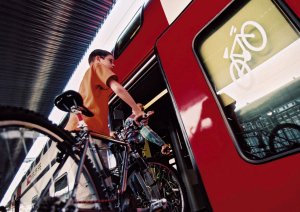Trains and Bikes
Below is a very interesting opinion piece from today's Hartford Connecticut Courant (see text below) written about the importance of including dedicated space for bicycle on rail train cars.
I agree with the author that room should be made on the trains for bikes. And in the mean time, many people can benefit by using folding bicycles when commuting by train, as an alternate way to get access, if access is unreliable or currently unavailable.
However, even with the ability of accessing rail train cars by using folding bicycles, policy decision makers should proceed with providing space for bicycles on rail train cars.

Make Room For Bikes On Rail Cars
September 3, 2006
By RICHARD M. STOWE

Last month the State Bond Commission approved $459 million toward the largest purchase of rail cars in state history - 300 new M8s (with an option to purchase 80 more) from Kawasaki Rail Car Inc. and $25 million toward refurbishing existing rail cars. Initial delivery for new cars is due in 2009.
The good news is that these cars are designed to run not only on Metro-North Railroad's New Haven line, but also on the state Department of Transportation's Shore Line East corridor.
The bad news is that the design for the M8 cars does not yet include dedicated space for bicycles.
Connecticut should formulate a statewide transportation strategy in which the bicycle replaces the automobile for many short trips and commuter rail replaces the automobile for many longer trips.
This transportation strategy will help reduce our addiction to oil and mitigate its unwanted effects - blood-stained fields in the Middle East, oil-soaked waters in the Mediterranean, global warming, the coming global peak oil crisis, unacceptably high numbers of motor vehicle-related deaths and injuries, air pollution, continued gas price increases and mind-numbing congestion on our highways.
To increase rail safety and speed, we should invest in infrastructure, such as signal upgrades, double tracking and grade separation projects, as well as the new rail cars. Similarly, we should improve bicycle safety by the judicious development of multi-use trails and by using bicycle-friendly road design. Car lanes may be narrowed and shoulders widened by simply repainting roadway edge striping. Narrower car lanes calm traffic and wider shoulders
improve safety for bicyclists.
Finally, bicycles and trains should be coupled in an intermodal strategy, in which cyclists are encouraged to bring their bikes on trains.
Nationally, this was once discouraged by requiring riders to buy bicycle permits and by keeping bikes off peak-hour trains.
When these impediments are removed (Gov. Christine Todd Whitman eliminated permits in New Jersey), and separate bicycle parking areas on new train cars are established, more bicyclists commute by train.
Examples of rail lines that have dedicated bicycle parking on their train cars include Tri-Rail (from West Palm Beach, Fla., to Miami), Caltrain (from San Jose, Calif., to San Francisco), Altamont Commuter Express (Stockton, Calif., to San Jose), Metrolink (a six-county Los Angeles metro region), Coaster (San Diego County), Pacific Surfliner (San Diego to San Luis Obispo, Calif.) and Capitol Corridor (San Jose to Sacramento). Central Florida Commuter Rail will provide bike parking on its train cars when the 61-mile commuter rail line serving the Greater Orlando area opens in 2009.
And in Europe, bicycle parking on trains is the rule, not the exception.
It is time for Connecticut to join the parade by providing bike parking on the new M8 train cars.
The new and refurbished cars will give Metro-North's New Haven Line excess capacity for the first time in its history. With a larger inventory of rail cars, Metro-North can not only provide dedicated space on its new rail cars for bicycle parking, but also more frequent train service.
Letting cyclists bring their bikes on trains will reduce demand for scarce motor vehicle parking spaces at stations. Bicycling becomes a feasible way to commute to work without a car.
Including bicycle parking in the final design of the rail cars is a cost-effective investment in our public transportation system. Bypassing such an investment now may lead to much more expensive retrofits at a later date.
Connecticut will soon see the benefits. And it will likely be emulated by other state rail agencies on the Northeast Corridor. Let's encourage Connecticut legislators and officials to provide safe, sensible, efficient and health-minded transportation for residents, employees and visitors.
Richard M. Stowe of New Canaan is director of Rail Transportation Excellence Coalition of Connecticut and president of the New Canaan Environmental Group, an environmental education organization.
Recommended Links:
- Cycle Santa Monica community forum




No comments:
Post a Comment